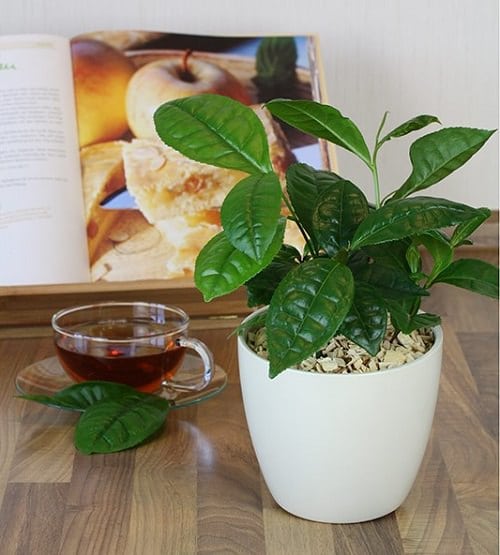Growing Tea Leaves at Home is an easy and fun experience. Go through the article and brew a cup from homegrown tea leaves!

Growing tea at home can be rewarding and fun. The best part is, you can also grow it in your balcony or patio! There’s nothing like watching a tea plant grow and sipping a piping hot tea made from the homegrown, organic tea leaves! Here’s everything about Growing Tea Leaves at Home!
Botanical Name: Camellia Sinensis
USDA Zone: 6-10
Check out our article on growing Coffee at home here
What are Tea Leaves?
True tea (black, green, white) originate from the tea plant. It is a hardy evergreen plant that features fragrant, shiny green and pointed leaves. This small shrub can grow up to 3-7 feet (1-2 m) tall. However, if not pruned, it can grow even taller. During the fall season, the tea plant produces aromatic small white flowers.
This plant is not fussy about the growing conditions, but it grows slowly from the seed. So, it will be better to grow it from cuttings or get a plant from a nursery.
Here are the best types of tea leaves
Planting Time
Tea is a perennial plant. You can plant it at any time in a year, as far as the climate is not very cold or extremely hot, though it can survive a light frost but doesn’t grow well in a freezing environment. It will be best to grow tea in spring or fall.
Note: If you are living in a tropical or subtropical climate, you can grow tea plants at any time in a year.
Types of Tea to Grow at Home
Camellia Sinensis has two subspecies: Sinensis (from China) and Assamica (Assam, India). Sinensis is hardy and has smaller leaves; it grows in cold places. While Assamica is a taller plant and it grows in moist and low elevated tropical areas.
Propagation
The tea plants can be propagated from seeds. You can also buy plants from a local nursery or online.
Container Size
A tea plant can be grown in a 6-8 inches pot. A mature shrub needs to be transplanted in a standard 12 inches pots.
Requirements for Growing Tea Leaves at Home

Location
Place the pots in a warm and partially shaded spot for optimum growth.
Soil
Use acidic soil with a pH range of 4.5-5.6. Check the acidic content of the soil by strip test with color codes. If the soil is not acidic, add sulfur and pine needles to it.
Water
Water your tea plants regularly and make sure that it is not going dry anytime. The soil must be slightly moist to touch always but not soggy.
Tea Plant Care

Fertilizer
Tea plants are hardy and rarely require fertilizer. If your plants are not growing properly, nourish the plants with ericaceous food, which is an acidic compost that contains all specific nutrients required for green leaves—Spread 1-inch of it around the plant.
Alternatively, you can also fertilize it with nitrogen-rich fertilizer, in 8-10 week intervals, during the growing season and in 12-14 week intervals during winter.
Winter Care
If you live in a cold climate, move your tea plants to a warm location when the temperature drops to the freezing level. It will be better to move them to a greenhouse or sheltered place. Remember, it can withstand cold and droughts but may die if the temperature drops below 32 F (0 C).
Pruning
You can start pruning after 2-3 years. Pruning helps to remove diseased, unproductive, or dead parts from the plant. Regular tea pruning improves the quality of the leaves and increases the yield of the plant too.
Harvesting and Storage
When the plant grows up to 2-3 feet tall, you can harvest the leaves. Gently handpick 3-4 bright green leaves from the plant. The leaves are now ready for tea. You can harvest tea leaves several times during spring and summer. Remember, regular harvesting helps the plant grow at a faster pace.
Processing Tea Leaves
Black Tea
- Pluck the young leaves and buds. Roll and crush the leaves on your hand until they turn dark and become red.
- Spread the leaves on a tray and leave for 2-3 days at a cool location.
- Dry them in the oven at 250 F (121 C) for up to 20 minutes and store in an airtight container.
Green Tea
- Pick young leaves and buds and allow the leaves to dry in a shaded area for a few hours.
- Steam the leaves on the stove for a minute. You can also roast them in a skillet for 2 minutes for a different flavor.
- Spread the leaves on a baking sheet and dry in the oven for 15-20 minutes at 250 F (121 -C).
- Store the dry leaves in an airtight container.
Oolong Tea
- Pluck young leaf buds and leaves. Spread on a towel in the sunlight for 45-50 minutes.
- Take the leaves indoors and keep them at room temperature for a few hours.
- When the leaves dry, the edges will turn red. Spread the leaves on a baking sheet and dry in the oven for 15-20 minutes at 250 F (121 C)
- Store in an airtight container.
White Tea
- Pluck young leaves before they are fully open. Pick the leaves on a warm day and leave them in sunlight for the entire day.
- Remove the stems and heat the leaves in a dry, hot skillet for 2-3 minutes.
- Allow the leaves to cool down and store in an airtight container.
Here are essential ingredients you can grow in your balcony for powerful tea
How to Brew a Perfect Cup of Tea?

So, what after growing the organic teal leaves yourself? Well, it’s time to enjoy a cup of it! To brew the incredible flavor here’s what you should be doing like tea lovers in the Indian subcontinent do.
- First, warm the ceramic teapot with hot water and give it a little swirl around and drain the water.
- Now, add the processed tea leaves. The right measurement is one spoon per person and one spoon for the pot. So, for one cup, add two spoons of tea to the teacup.
- Take filtered water and boil it. Do not overboil.
- Pour the boiling water to the teacup containing leaves and cover it with a dark cloth,
- The minimum time you must give the tea to brew correctly is 5 minutes.
- Remove the cap of the teapot and stir it nicely.
- Pour it in a cup using a strainer and relish the homegrown tea with your friends and family members looking over the sunlit sky!


